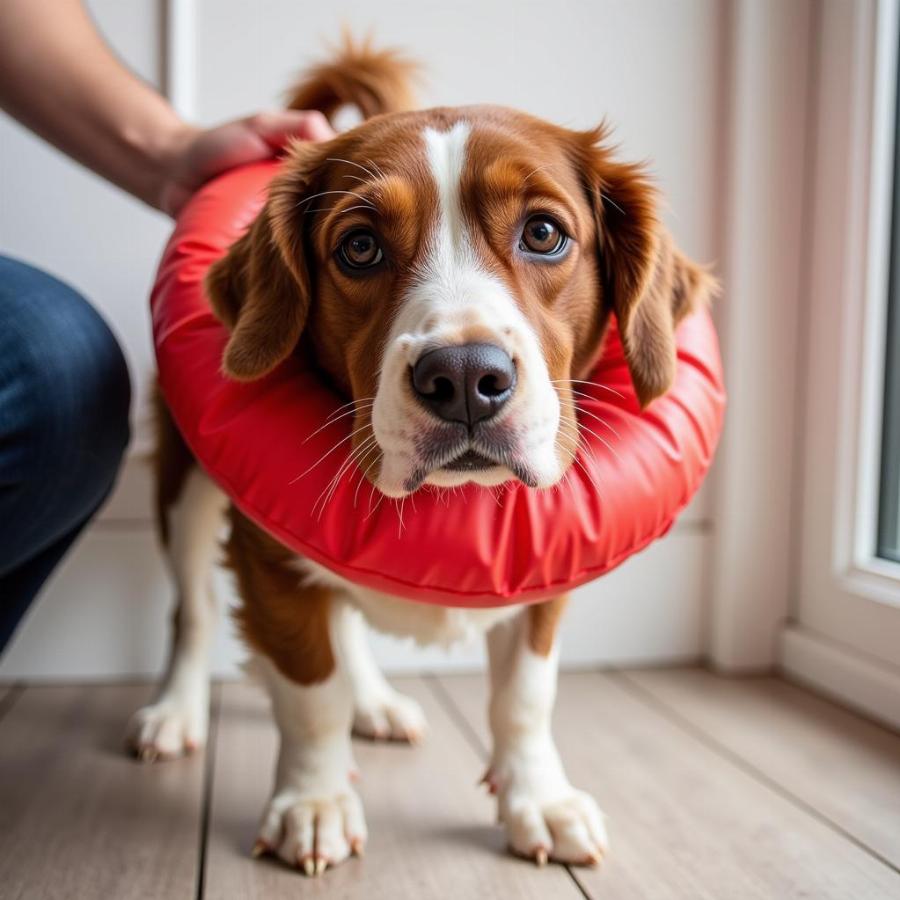Dog inflatable collars, also known as E-collars or donuts, are a common sight after a dog undergoes surgery or has an injury that requires them to avoid licking or scratching. While they might look a little funny, these collars play a crucial role in protecting your furry friend during the healing process. This comprehensive guide will delve into everything you need to know about dog inflatable collars, from understanding their purpose and benefits to choosing the right size and ensuring your dog’s comfort.
Why Use Dog Inflatable Collars?
After surgery or when dealing with a wound, your dog’s natural instinct is to lick or scratch the affected area. While this might seem harmless, it can actually hinder healing, introduce infections, and even reopen stitches. Dog inflatable collars provide a physical barrier that prevents your dog from accessing the wound, allowing it to heal properly without interference.
Benefits of Inflatable Collars over Traditional Cones
Traditional cone-shaped collars, often made of hard plastic, have been the go-to solution for wound protection in dogs. However, inflatable collars offer several advantages:
- Increased Comfort: The soft, inflatable design is much more comfortable for dogs to wear compared to the rigidness of a traditional cone.
- Improved Visibility: Inflatable collars don’t obstruct the dog’s peripheral vision as much as cones, reducing anxiety and disorientation.
- Easier to Eat and Drink: While it might take some adjustment, dogs can generally eat and drink more easily with an inflatable collar.
- Lightweight and Portable: Inflatable collars are lightweight and can be easily deflated for storage or travel.
Choosing the Right Size Inflatable Collar
Selecting the correct size is crucial for your dog’s comfort and the collar’s effectiveness.
- Neck Circumference: Measure around the widest part of your dog’s neck.
- Collar Width: Ensure the collar is wide enough to prevent your dog from reaching the wound, but not so wide that it restricts their movement or breathing.
Consult your veterinarian or refer to the manufacturer’s sizing chart to determine the appropriate size for your dog’s breed and weight.
Helping Your Dog Adjust to an Inflatable Collar
It’s normal for dogs to need some time to adjust to wearing an inflatable collar. Here are some tips to ease the transition:
- Positive Reinforcement: Reward your dog with treats and praise when they remain calm while wearing the collar.
- Gradual Introduction: Introduce the collar gradually, allowing your dog to sniff and investigate it before putting it on.
- Supervise Initially: Monitor your dog closely when they first wear the collar, especially during activities like eating or playing.
 Dog getting used to an inflatable collar
Dog getting used to an inflatable collar
Tips for Using Dog Inflatable Collars
- Keep it Clean: Regularly clean the collar with a damp cloth and mild soap to prevent dirt and bacteria buildup.
- Check for Air Leaks: Ensure the collar is properly inflated and check for any air leaks.
- Don’t Leave it On Unattended: Supervise your dog while they are wearing the collar and remove it when you can’t be around to monitor them.
Alternatives to Inflatable Collars
While inflatable collars are generally a great option, there are alternatives available, such as:
- Soft E-collars: Made from soft, flexible materials like fabric or foam, these offer a comfortable alternative to traditional cones.
- Neck Braces: For specific injuries, neck braces can provide support and restrict movement while allowing for greater freedom than a collar.
- Surgical Recovery Suits: These full-body suits can be a comfortable and effective alternative for some dogs, providing protection for wounds and incisions.
Conclusion
Dog inflatable collars are a valuable tool for protecting your furry friend during the healing process. By understanding the benefits, choosing the right size, and helping your dog adjust, you can make the experience as comfortable and stress-free as possible. Remember to consult with your veterinarian to determine the best option for your dog’s specific needs and always prioritize their comfort and well-being.
Frequently Asked Questions
Q: Can my dog sleep with an inflatable collar?
A: Yes, most dogs can comfortably sleep with an inflatable collar. However, always monitor your dog initially and remove the collar if they seem distressed.
Q: How long will my dog need to wear the inflatable collar?
A: Your veterinarian will advise on the duration, which typically ranges from a few days to a couple of weeks, depending on the severity of the wound.
Q: Can I use an inflatable collar for a puppy?
A: Yes, inflatable collars come in sizes suitable for puppies. Ensure you choose the correct size and closely supervise your puppy.
Q: What should I do if the inflatable collar deflates?
A: Check for any punctures or leaks and re-inflate the collar. If the problem persists, replace the collar.
Q: Can I wash my dog’s inflatable collar?
A: Yes, most inflatable collars are washable. Refer to the manufacturer’s instructions for cleaning recommendations.
Looking for more advice on caring for your dog after surgery or an injury? Check out our articles on donut cone for dogs and dog post surgery onesie.
You might also be interested in our guide to dog christmas pajamas for festive fun with your furry friend.
Need More Help?
Beaut Dogs is here to support you every step of the way on your journey as a dog owner. For personalized advice and expert tips on all things dog-related, contact our team at [email protected]. We’re always happy to help!